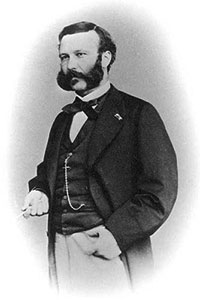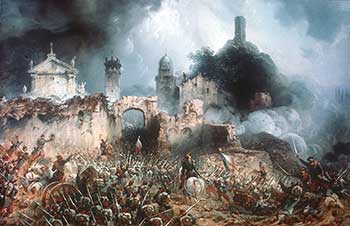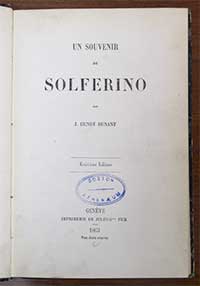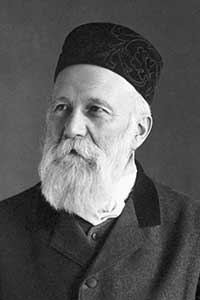A Journey that Remade One Man’s Life and Bettered the World For All.

Every traveler has had a bad experience — a connection missed, or a hotel reservation misplaced — but thankfully few have encountered a situation like that Henry Dunant faced on an 1859 business trip to Italy. Approaching Solferino, he found himself in the midst of the bloodiest European battle in more than 40 years.1 Dunant never got the contract he needed, but the experience changed his life forever, and through his life’s work, improved the lives of people everywhere.2
Dunant's Original Mission. Dunant was a 31-year old Swiss businessman with a grain mill in French-ruled Algeria. It was supposed to turn the region into a breadbasket for Europe, but the venture suffered from insufficient acreage and water. Officials in Paris met Dunant’s requests for additional water rights with bureaucratic delay and indifference. Eventually he concluded that his only chance would be to petition Napoleon III himself, so he set out to find the Emperor, who was commanding French troops in Italy.
The Battle of Solferino. The French were in Italy to support Sardinian freedom fighters seeking to oust the Austrian rulers of Northern Italy and establish an independent state. Napoleon III hoped the campaign would rekindle memories of his uncle Napoleon’s days of military glory. The allied French-Sardinian forces had already won several battles and were advancing on the town of Solferino.

Neither side had planned to fight at Solferino, but with 300,000 troops massed along a sixteen kilometer frontier, conflict was inevitable. Brutal combat left 6,000 dead, many times as many wounded, and the French and their allies in possession of Solferino.
Dunant’s Mission Changes. Dunant’s carriage approached Solferino as the fighting was ending. He was shocked to see dead and wounded soldiers lying in the fields and little being done to assist them. Arriving in the town of Castiglione, he found the French only had six physicians for 9000 wounded. Apparently this wasn’t unusual, since commanders had little incentive to devote resources to soldiers who no longer could fight.
Dunant did what he could to help distressed soldiers regardless of nationality and enlisted the aid of anyone who would join him. Local women were reluctant to help at first, fearing reprisals should Austrian troops return, but eventually they worked in the temporary hospitals Dunant established in local churches. A retired naval officer, four English tourists and a young French count pitched in as well.
Dunant sent his coachman to a nearby town for lemons, camomile, sugar and other supplies and wrote to wealthy friends in Geneva requesting immediate assistance. The volunteers helped wounded and dying soldiers send letters to loved ones at home.
When Dunant learned that captured Austrian army doctors were being held as prisoners, he convinced Napoleon III to release them so they could assist the sick and wounded. Again, aid was provided regardless of nationality. The relief mission’s mantra became Tutti Fratelli, meaning “all brothers,” acknowledging that all sick and wounded are equally deserving of help.

A Haunting Memory. Dunant returned to Paris without ever having asked Napoleon III for the water rights. He attempted to resume his previous life, but the horrors he had witnessed haunted him. After two years, he returned to Geneva and wrote a book about his experience called A Memory of Solferino. He published and distributed it at his own expense and sent copies to most of the rulers and other influential people in Europe. It was an immediate success and gave Dunant a voice on the world stage.
The book summarizes the battle and relief efforts at Solferino, but more importantly suggests remedial steps, specifically:
- The establishment of organizations to stockpile emergency medical supplies and train volunteers to aid the wounded of all nationalities in time of war; and
- The adoption of international legal protections for relief workers and their facilities.
The ICRC and Geneva Convention. Dunant’s proposals struck a responsive chord. In 1863, he was invited to join a meeting of the Geneva Society for Public Welfare, which appointed a committee to look into implementation of his proposals. Later that year, a conference was held in Geneva that led to founding of the International Committee for Relief to the Wounded (today the Red Cross). The next year a meeting was convened to craft the first Geneva Convention on the Rights of Combatants. The Red Cross provided relief supplies and trained volunteers and the Geneva Convention assured their protection.
Dunant had learned from a physician that relief workers sometimes were attacked because their non-combatant status wasn’t clear. Even if a doctor or nurse’s uniform bore medical insignia, their meaning might not be known to soldiers in other armies. Dunant proposed that all countries agree upon a universally recognized, easy to identify symbol. He suggested a red cross.
Dunant’s Fate. Dunant’s humanitarian work took him away from his business and it failed in 1867. He resigned from the ICRC in disgrace and made his way from place to place relying on the generosity of friends. Once, when French Empress Eugenie wanted to consult with him on extending Geneva Convention protections to naval warfare, he was found sleeping on a Paris park bench.

Despite his personal misfortunes, Dunant continued his humanitarian work. He personally rendered aid in Paris during the Franco-Prussian War and later during the Paris Commune. In 1875, he organized a conference in London on the final elimination of the slave trade.
Eventually Dunant found his way to the Swiss town of Heiden on Lake Constance and faded from public view. Many assumed he had died.
Then in 1895, a reporter found him living in a hospice in Heiden. Within days, Dunant’s name was again in the papers. Messages of support and adulation poured in on his birthday in 1896. Dunant, however, shunned the attention and continued his isolation.
The Nobel Peace Prize. As the world was hearing of Dunant’s life in Heiden, Alfred Nobel was finalizing his will in Paris. It provided for annual awards in recognition of service to humanity, including one for contributions to world peace.
Many had expected the first Nobel Peace Prize to be given to French pacifist Frédéric Passy; however, nominations of Dunant were received from around the world. In the end, the first Nobel Peace Prize was awarded jointly to Passy and Dunant.
After years of subsistence living, Dunant might have been excused a few indulgences with his share of the prize money. But he refused to touch it and in his will left everything to various charities, including the hospice in Heiden where he lived from 1892 until his death in 1910. There he endowed a free bed for those among the poorest residents of the town who were sick.
* * * * *
The great thing about history is that the stories are so much better than fiction, perhaps because the people living them don’t have to worry whether readers will find them plausible. A novel about colonial shopkeepers and farmers defeating the military superpower of the day would quickly be dismissed as absurd. But George Washington and John Adams didn’t know that, they just did it. The story of Henry Dunant is yet another of those fantastic stories that is all the more inspirational because it is true.
-----
- The earlier battle was Waterloo in 1815.
- Information for this article comes from Pierre Boisser, Henry Dunant, Henry Dunant Institute (1974); Caroline Moorehead, Dunant’s Dream, War, Switzerland and the History of the Red Cross, Carroll & Graf Publishers, Inc., New York (1999); Francois Bugnion, A History of Humanity, video by International Committee of the Red Cross (2014), available on YouTube.Brad Smith and Carol Ann Browne, “What’s to be Learned from the Founding of the Red Cross?”, from Today in Technology on the Microsoft web site (date not given).
- Image from article about Henry Dunant on the web site of the ICRC.
- Carlo Bossoli, Battle of Solferino (1859). Image from Wikipedia.
- Photo of Henry Dunant around 1901. Image from Nobel Prize web site.
This article originally appeared in our free semi-monthly newsletter. To receive future issues, please add your name to the subscription list.

